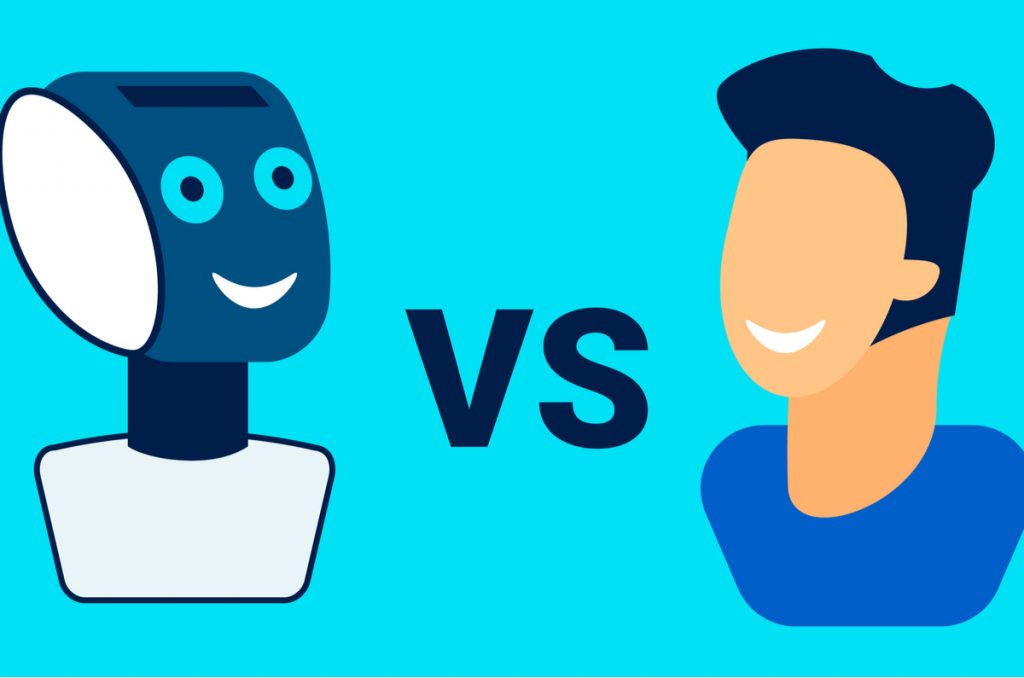
As a starting point, let’s define live chat and chatbots.
The use of live chat is a website-integrated method of customer service. Instant support can be provided to site visitors by using this direct messaging tool. It serves as a replacement for real-life salespeople and phone support. Your customers don’t have to leave your website to get answers to their questions.
Automated systems that respond to customers’ queries without human intervention are known as chatbots. Chatbots can be divided into AI-powered and rule-based bots. Unlike rule-based chatbots, conversational AI chatbots use machine learning and natural language processing (NLP) technology to mimic human conversation.
Chatbots and live chats differ primarily in that a human agent is in charge of the conversation, whereas live chats are run by a computer.
Chatbots vs. Live Chat: What’s the Difference?
Chatbot
Chatbots appear to be popular with consumers. 40% of people would rather interact with a computer than with another human being. Owners of businesses must also consider their own interests.
Businesses can gain many advantages from using chatbots
- Availability at all times: It’s possible to get in touch with customer service any time of day or night.
- Waiting times have been reduced: Automated bots respond to questions immediately rather than requiring users to wait for an agent to answer them.
- Improved teamwork: Customer service and support teams can focus on more important tasks, such as handling complaints and resolving issues, without being distracted by repetitive messages.
- There was no omission of any conversations: It is impossible for you to miss a request because bots handle them for you.
- Savings on the part of the consumer: A reduction in the number of customer service representatives is expected when the majority of inquiries are handled automatically.
- Improvements to the customer experience: It is possible to enhance the customer experience by using automation.
Chatbots, on the other hand, have the following drawbacks:
- Difficulty in establishing: Artificial intelligence (AI)-powered chatbots take a long time and a lot of work to set up.
- Inability to change course when necessary: Most small businesses rely on rule-based chatbots, which have a limited set of scenarios. An unanticipated event will prevent chatbots from continuing their conversation. As a result, customers may become dissatisfied and have a negative experience.
- Human interaction is not possible: Bots are unable to convey emotion, empathy, or provide in-depth solutions.
- Missed opportunities result from a lack of instinct: It is always possible for an experienced sales representative to identify upsell and cross-sell opportunities. In contrast, chatbots lack this instinct. As a result, chatbots can’t do it all.
Live Chat
What are the benefits of using live chat?
- Improved customer service: Customers are more satisfied when their questions are answered immediately and they receive ongoing assistance throughout the purchase process.
- It’s easy to set up: The first step is to add a chat widget to your website. This can be achieved by using integrated marketing automation platforms. Explore Sendinblue’s chat capabilities.
- A better relationship with the customer: Customer service representatives have the power to improve the brand’s reputation and strengthen customer loyalty through their actions and decisions (e.g. offering complimentary gifts or discounts).
- Perceptions of customers: Live chat interactions with customers and prospects reveal the most common issues they face. Use them to solve common issues and boost customer satisfaction.
- A higher rank: A customer service representative can better understand a prospect’s needs and make more relevant recommendations in a one-on-one conversation.
- Techniques for effectively resolving problems: Live chat agents’ abilities are not limited to predefined workflows; they can resolve complex, unique issues that bots cannot.
It’s important to keep in mind the following drawbacks of live chat:
- There is a limited supply: Chat support hours are determined by the working hours of your customer service representatives. Your live chat will be unavailable when they log off for the day. Having multiple support teams located in different time zones is essential if your company intends to serve customers around the clock, seven days a week.
- Wait time: Because of the high volume of requests, it is unlikely that all of them will be addressed right away by your customer service representatives. Your brand’s reputation could be damaged if they take too long to load.
- Costs have gone up: Having more people on a project necessitates a larger team. As the number of employees grows, so does the cost of doing business.
- Only a limited number of seats are available: Multiple conversations are not possible at the same time. The volume of inquiries, the difficulty of the questions, and the efficiency of the agents will all affect capacity.
- Prone to errors: Errors committed by chatbots are less likely than those committed by humans. When replying or closing a chat, it is possible to misspell a person’s name or close the wrong chat. This is the price we pay for being genuine and empathic.
When it comes to implementing live chat, it’s easier, but there’s a limit. As of now, it appears that the best strategy for conversation is to use both.